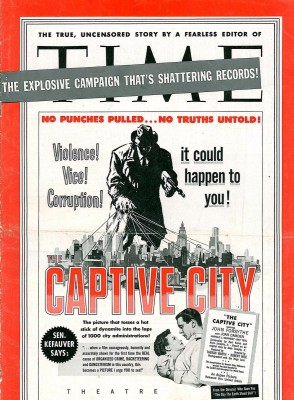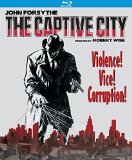| Reviews & Columns |
|
Reviews DVD TV on DVD Blu-ray 4K UHD International DVDs In Theaters Reviews by Studio Video Games Features Collector Series DVDs Easter Egg Database Interviews DVD Talk Radio Feature Articles Columns Anime Talk DVD Savant Horror DVDs The M.O.D. Squad Art House HD Talk Silent DVD
|
DVD Talk Forum |
|
|
| Resources |
|
DVD Price Search Customer Service #'s RCE Info Links |
|
Columns
|
|
|
Captive City, The
Innovatively, Wise shot the entire film on location in Reno, Nevada. There are no studio interiors, and Wise eschews other conventions like rear-projection for shots taken inside moving cars, even at night. Further, the cast consists almost entirely of actors unknown to the movie-going public in 1952, and what appear to be non-professional actors in smaller bits. He also utilized the then-cutting edge Hoge camera lens, a lens able to capture very tight, wide-angle shots with minimal lighting and with a very wide depth-of-focus. (At least I think those were its primary benefits.)
All this serves to lend The Captive City enormous verisimilitude and you-are-there realism. It's not quite a semi-documentary in the style of other noir such as The House on 92nd Street (1945), though similar. John Forsythe (making his film debut) stars as small town newspaper editor Jim Austin, whose harrowing experiences are based on those of Time magazine writer Alvin M. Josephy, Jr., co-writer of the screenplay.
Terror-stricken marrieds Jim (Forsythe) and Marge Austin (Joan Camden) are racing their car across the countryside, frantically try to reach the state capitol before men in the car pursuing them catches up. They make it a small town, run as fast as they can into the local police station and, still not certain that, even there, they're completely safe, ask for a police escort the rest of the way. Fearing for his life, Jim records the events of the past weeks into the station's reel-to-reel tape recorder.
In flashback, Jim recalls aging local private investigator Clyde Nelson (Hal K. Dawson) trying to sell skeptical Jim a red-hot front page story that local businessman Murray Sirak (Victor Sutherland) has effectively taken over the entire town, his reach extending to Police Chief Gillette (Ray Teal). Nelson claims the police have been impeding his alimony investigation on behalf of Sirak's alcoholic ex-wife. The police have been tailing him and badgering him with endless tickets over trivial infractions and, eventually, revoked his private investigator license. Jim doesn't take Sirak's claims seriously until he's found dead.
Jim then follows Sirak's lead and encounters the same thinly veiled threats and police denials Sirak did. Clues gradually lead him to wanted Sicilian mobster Dominick Fabretti (Victor Romito), a shadowy figure operating out of the back of a rented warehouse.
The Captive City, even 60-plus years later, remains admirably tense and exciting, tempered slightly by greater audience awareness of the Mafia in America and its dissemination in organized crime, a concept not nearly as shocking as it apparently was back in 1952. The gripping look and authentic feel of the picture are undermined slightly by Hollywood movie conventions here and there, such as Jim's introductory remarks into that tape recorder, introducing his small town in civic-minded travelogue tones instead of cutting to the chase with the facts of his life-threatening dilemma.
It was one of several movies all made about the same time extolling the virtues, indeed the necessity of a free press operating independently from government and criminal interference: two other examples from that same year were Deadline U.S.A., with Humphrey Bogart, and Samuel Fuller's Park Row, the latter being especially good. The Captive City begins with a much too cozy relationship between Jim's paper and the local police, cordial on the assumption than an adversarial one would hardly be required in a small town where nothing much happens.
As others have noted, The Captive City almost plays like a warm-up to events in Santa Mira in Don Siegel's Invasion of the Body Snatchers (1956). How could a town so outwardly idyllic be so corrupted by an alien (i.e. foreign criminal) menace? Like animated maps during World War II and of the early Cold War, in which a schematic octopus's black tentacles stretch to invade friendly borders, the movie builds suspense wondering, like Jim, just how far its corruptive influence has spread. Further, as Jim digs deeper, he discovers that his neighbors are likewise flawed, often unhappy human beings: people in debt, alcoholics, cops on the take. Even the town's ministers shrug and insist nothing can be done.
If The Captive City seems a bit tame today, Wise compensates quite a bit with the look of the film, which still seems very fresh and alive, if imperfectly realized. In many shots local extras, obviously dazzled by the glamorous Hollywood production, can't help gazing at the camera. In one nightclub scene one extra on the dance floor unsubtly keeps positioning herself so that her smiling face is always on-camera.
Video & Audio
Originally a United Artists release, The Captive City has been licensed to Kino Lorber from MGM, who have provided a crisp standard size (1.37:1), black-and-white transfer. Audio is mono English only with no subtitle options, and the disc is region A encoded.
Extra Features
The only supplement is the usual trailer.
Final Thoughts
A taut, still-suspenseful noir from undervalued director Robert Wise, The Captive City is Highly Recommended.
Stuart Galbraith IV is the Kyoto-based film historian and publisher-editor of World Cinema Paradise. His new documentary and latest audio commentary, for the British Film Institute's Blu-ray of Rashomon, is now available.
|
| Popular Reviews |
| Sponsored Links |
|
|
| Sponsored Links |
|
|
| Release List | Reviews | Shop | Newsletter | Forum | DVD Giveaways | Blu-Ray | Advertise |
|
Copyright 2024 DVDTalk.com All Rights Reserved. Legal Info, Privacy Policy, Terms of Use,
Manage Preferences,
Your Privacy Choices | |||||||














